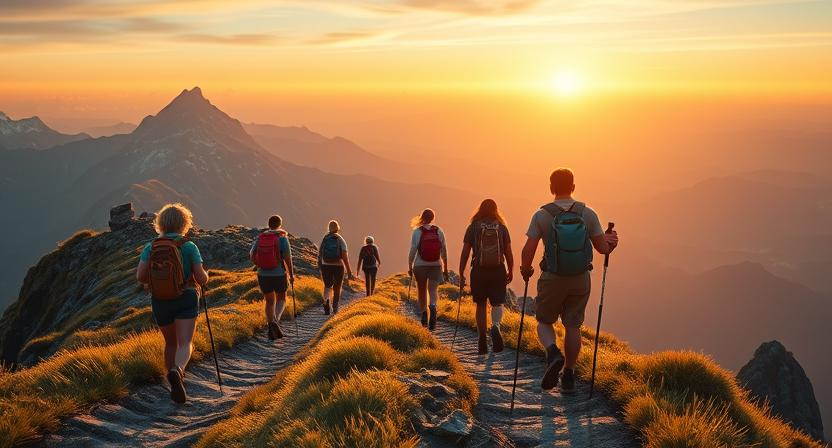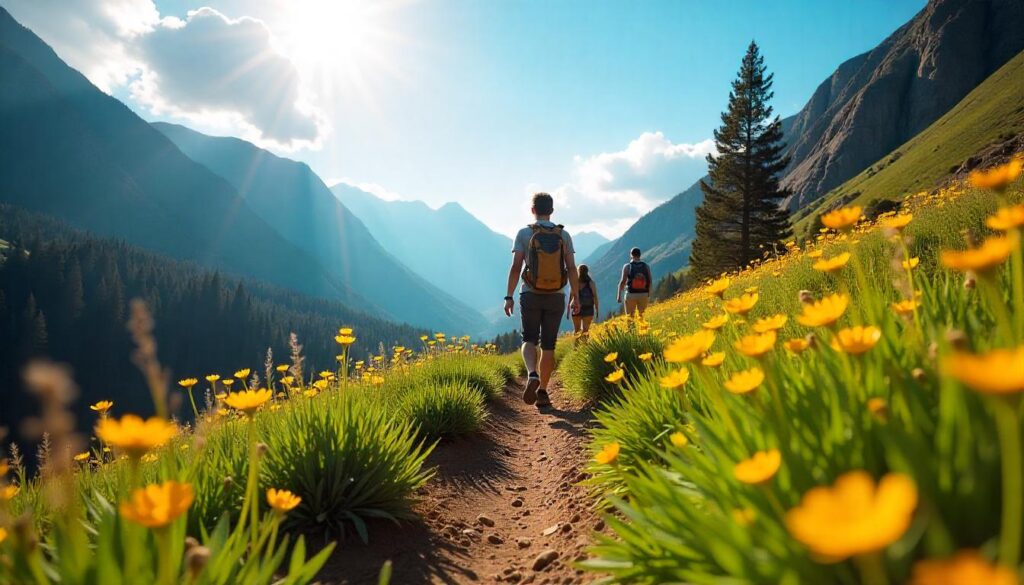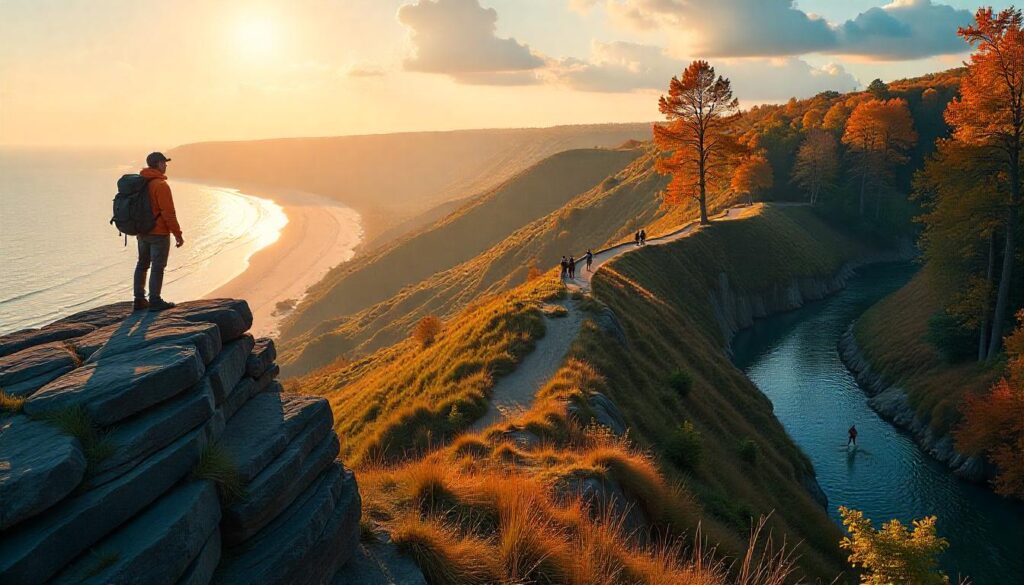
Discover why hiking in Indiana is more than just a weekend pastime—it’s an opportunity to explore rolling hills, towering dunes, and hidden cascades across the Hoosier State. From the wind‑blown ridges of the Indiana Dunes National Park to the moss‑lined ravines of Brown County, this guide will equip you with the insider knowledge to plan unforgettable outdoor adventures. Whether you’re following rumbling waterfall trails or mapping out a multi‑day backpacking route, you’ll find authoritative tips and personal insights here to help you hit the trail with confidence.
With over 1,000 miles of Indiana hiking trails, you’ll encounter everything from gentle boardwalk loops to rugged ridge routes. Explore the gentle slopes of the Indiana mountains near Clifty Falls, traverse the wind‑sculpted sands of Lake Michigan’s shore, or chase sparkling Indiana waterfalls deep in state forest gorges. Each region offers its own flavor: the oak savannas of central Indiana, the cascading bluffs of northern Indiana, and the hidden waters of southern grottos. No matter your experience level, you’ll find a trail that matches your pace and piques your curiosity.
This ultimate guide covers:
- Why hiking in Indiana is a must—learn what makes the state’s terrain so varied and welcoming.
- Planning your adventure—from permits and park fees to essential gear checklists for backpacking in Indiana.
- Top trails and hidden gems—our pick of the best hikes in Indiana, plus off‑the‑beaten‑path recommendations.
- Seasonal considerations—month‑by‑month advice on the best time to visit to see wildflowers, autumn foliage, or frost‑tipped falls.
- Safety and resources—weather warnings, wildlife precautions, and links to official trail maps and guidebooks.
As someone who’s hiked over 200 miles across Indiana trails, here’s my top tip for first‑timers: invest in a good pair of waterproof hiking boots and learn to read trail markers before you set out. Hoosier terrain can shift from sandy dunes to slippery rock slabs in a single mile. And don’t forget to pack layers—even in summer, early‑morning temperatures can dip into the 50s. Ready to lace up? Let’s dive into everything you need to know to make the most of hiking in Indiana.
Why Hiking in Indiana Is a Must
Indiana may not have towering peaks, but its diverse landscapes—from rolling hills and sandstone ravines to windswept dunes and hidden waterfalls—make hiking in Indiana a year‑round adventure. You’ll find over 1,000 miles of Indiana hiking trails that cater to every skill level and interest, whether you crave a family‑friendly stroll or a challenging backpacking expedition. The state’s central location and well‑maintained parks mean you’re never far from a trailhead, making spontaneous weekend escapes both easy and rewarding. As an experienced Hoosier hiker, I’ve seen how a simple sunset walk on a ridge can feel as epic as summiting a western peak.
Indiana Mountains & Hilly Landscapes
While Indiana lacks true alpine summits, its mountains in Indiana take the form of high ridges and escarpments that offer spectacular views. The Knobstone Escarpment in southern Indiana delivers a “mountain‑like” feel, with trails that wind along rugged ridgelines and dense oak‑hickory forests. In the east, the rolling hills of the Hoosier National Forest and Clifty Falls State Park showcase limestone cliffs and steep valleys carved by millennia of water erosion. These landscapes prove that you don’t need 14,000‑foot peaks to chase breathtaking panoramas and challenging terrain.
Are There Mountains in Indiana?
No, Indiana doesn’t have mountains in the classic sense, but the state’s high‑elevation ridges—like those on the Knobstone Trail—offer the next best thing. These rocky escarpments rise several hundred feet above the surrounding farmland, creating a mountain‑like hiking experience within easy reach of Indianapolis and Louisville. According to the Indiana Department of Natural Resources, these ridges formed as ancient sea beds were uplifted and eroded, leaving behind the dramatic slopes we explore today¹.
Does Indiana Have Mountains or Gentle Hills?
Most of Indiana’s terrain consists of gentle hills, especially across the central and northern regions, where glacial deposits smoothed the land into rolling farmland and wetlands. In contrast, southern Indiana boasts the steepest slopes, with sandstone outcrops and valleys that feel surprisingly rugged. Whether you prefer a mild walk through meadow‑dotted hills or a heart‑pumping climb up sandstone bluffs, Indiana’s varied topography delivers both mountain-esque adventures and easy‑going hill hikes.
Indiana Dunes National Park Hiking
Along the southern shore of Lake Michigan lies one of the country’s newest national parks: Indiana Dunes National Park. Here, shifting sand dunes rise up to 200 feet above the lake, backed by wetlands, prairies, and forests that support a remarkable diversity of plants and wildlife. Hiking in Indiana Dunes is an ever‑changing experience: one day you’re scrambling up a dune ridge, the next you’re wading through a coastal bog alive with songbirds. This mosaic of ecosystems makes the Dunes a must‑visit for anyone exploring hiking in Indiana Dunes.
Indiana Dunes Hiking Trails & Map
The park’s trail network spans over 50 miles and is clearly marked on official maps available at visitor centers or online via the National Park Service². Key routes include:
- Cowles Bog Trail: A 3.5‑mile loop through dune ridges and restored prairie.
- Dune Succession Trail: A 1‑mile interpretive walk illustrating dune formation.
- Paul H. Douglas Trail: A 2.5‑mile paved path ideal for beginners and families.
Carry the Indiana Dunes hiking map or download an offline version of the park’s GIS map on Gaia GPS for reliable navigation in remote areas.
Best Trails Indiana Dunes & Hiking at Indiana Dunes
For the quintessential Dunes experience, climb the Mount Baldy dune on the Cowles Bog Trail at sunrise—local hikers swear the 360° lake and prairie views are unmatched. If you’re seeking solitude, the Valley Trail’s western section leads through mixed hardwoods and rarely sees crowds. For a groomed, accessible option, the Porter County trails near Indiana Dunes State Park offer gentle boardwalks along marsh edges—perfect for a quick sunset stroll.
Indiana Waterfalls & Cascades
Few things capture a hiker’s heart like the roar of rushing water. Indiana waterfalls may not match the grandeur of the Rockies, but they deliver plenty of charm and photo‑worthy moments, especially after spring thaw or heavy rains. From the multi‑tiered plunges of Clifty Falls to secluded cascades hidden in state forests, chasing these aquatic gems is one of the most rewarding aspects of hiking in Indiana.
Hiking Trails in Indiana with Waterfalls
Several state parks specialize in waterfall hikes:
- Clifty Falls State Park (Gorge Scenic Loop): Features four waterfalls along a 2.6‑mile loop east of Madison.
- McCormick’s Creek State Park (Wolf Cave Falls Trail): A 1.6‑mile path that passes Hemlock Cliffs and Wolf Cave Falls.
- Spring Mill State Park (Cataract Falls): The highest waterfall in southern Indiana, reachable via easy 0.6‑mile loop.
These hiking trails in Indiana with waterfalls combine moderate distances with dramatic scenery—just pack waterproof shoes and watch for slick rock when you cross streams.
Best Waterfalls in Indiana & Indiana Waterfalls
For the best waterfalls in Indiana, start with Upper and Lower Clifty Falls for their thunderous flow and deep gorge setting. Hemlock Cliffs at McCormick’s Creek offers a misty, intimate waterfall tucked under towering hemlocks. At Spring Mill State Park, Cataract Falls spills over full‑width limestone ledges, creating wide sheets of cascading water that are easy to view from the roadside or a short nature walk. For a hidden find, seek the seasonal falls along the Salamonie River in the state forest—accessible via a 3‑mile out‑and‑back that few hikers explore.
Planning Your Indiana Hiking Adventure
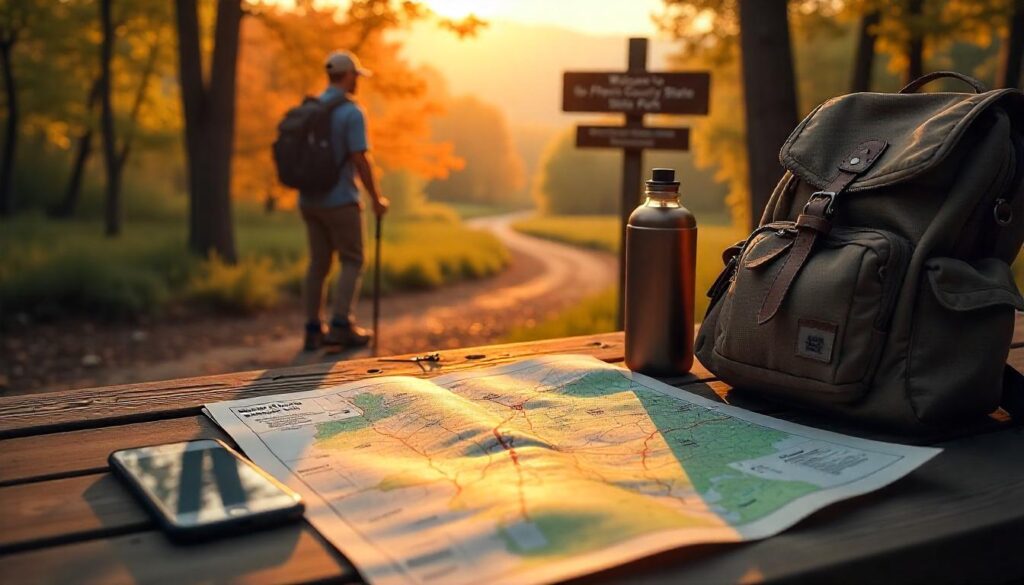
Embarking on hiking in Indiana is as much about preparation as it is about the trail itself. From securing the right permits to packing for a multi‑day trek, smart planning ensures you can fully enjoy the rolling hills, coastal dunes, and hidden waterfalls without surprises. Below, you’ll find everything you need to know to get started on your next Indiana trails journey—from fees and regulations to essential gear checklists and the best backpacking routes.
Permits, Park Fees & Regulations
Most day hikes in Indiana state parks only require a nominal entry fee—typically between $5 and $7 per vehicle—payable at self‑serve kiosks or online via the Indiana Department of Natural Resources¹. Backcountry backpacking usually doesn’t demand a special permit, but campsites in parks like Brown County or Clifty Falls often operate on a first‑come, first‑serve basis or allow advanced reservations through the park’s website. Always check individual park pages before you go, as some sensitive areas (e.g. Dunes Wilderness) impose seasonal closures or group size limits to protect fragile ecosystems.
For detailed regulations and fee schedules, visit the Indiana DNR’s official site.
Camping and Hiking in Indiana
Whether you’re planning a strenuous overnight trip or a weekend camping getaway, camping and hiking in Indiana blends front‑country comfort with backcountry solitude. State parks like McCormick’s Creek and Lake Monroe offer drive‑up campsites equipped with picnic tables and fire rings, perfect for families or first‑time campers. For a more rugged experience, the Indiana backpacking trails in Hoosier National Forest and Jackson‑Washington State Forest provide primitive campsites spaced along multi‑day loops—just be ready to pack in all your water and supplies.
Gear Checklist for Backpacking in Indiana
A well‑rounded gear checklist for backpacking in Indiana keeps you safe and comfortable on varied terrain:
- Footwear & Clothing: Waterproof hiking boots with ankle support handle wet dunes or slick bluff trails. Layered, moisture‑wicking clothes adapt to sudden temperature shifts, especially on ridge‑top winds.
- Shelter & Sleep System: A lightweight tent or hammock, plus a 20°F (–6°C) sleeping bag, tackles both warm summer nights and cooler spring or fall evenings.
- Hydration & Nutrition: Carry at least two liters of water in a bladder or bottles, and bring a reliable filter or purification tablets for creek refills. Pack high‑calorie, non‑perishable foods—trail mix, energy bars, and dehydrated meals—to fuel long days.
- Navigation & Safety: A paper Indiana hiking trails map complements GPS apps like AllTrails or Gaia GPS for remote sections. Don’t forget a headlamp, first‑aid kit, whistle, and bear‑safe food container (where required).
Indiana Backpacking Trails & Campgrounds
For those seeking solitude and a true backpacking in Indiana challenge, consider these standout loops:
- Eagle Rock Loop (Ouachita NF): Though technically in Arkansas, its Indiana counterpart, the Knobstone Trail’s southern section, offers rugged ridge camping and river crossings—ideal for seasoned hikers.
- Jackson‑Washington Backpacker Loop: A 24‑mile circuit with primitive campsites every 6–8 miles. Water sources are sporadic, so plan caches or carry filtration systems.
- Hemlock Cliffs & Wolf Cave Falls (McCormick’s Creek SP): Combine day hikes into a 12‑mile overnight trek, camping near the canyon rim for sunset views.
When planning, always follow Leave No Trace principles—camp 200 feet from water, pack out all trash, and leave natural features undisturbed.
Indiana Hiking Trails Map & Guidebooks
Even in our digital age, physical guidebooks and topographic maps remain indispensable for Indiana hiking trails:
- “Indiana Hiking Trails” by Tim Ernst: This authoritative guide features over 100 detailed trail maps and expert commentary on trail conditions, seasonal highlights, and local lore.
- Official State Park Maps: Free printed maps at park offices show trailheads, campgrounds, and restroom locations—download PDFs in advance from Indiana DNR’s website³.
- Trail Apps & Offline Tools: AllTrails and Gaia GPS allow you to download vector maps for no‑service zones. For deeper backcountry treks, consider specialized compasses and topo maps from ADC Map or National Geographic.
Top 10 Best Hikes in Indiana You Must Visit
Whether you’re chasing the roar of hidden waterfalls or seeking the sun‑baked ridges of Indiana Dunes hiking, the Hoosier State offers trails that suit every style. From sandstone canyons and forested hollows to coastal prairies and pastoral rail‑trails, these Indiana hiking trails represent the very best of hiking in Indiana. Lace up your boots and explore our hand‑picked list of ten must‑visit routes—each one guaranteed to showcase a unique facet of this diverse landscape.
1. Turkey Trail – Turkey Run State Park
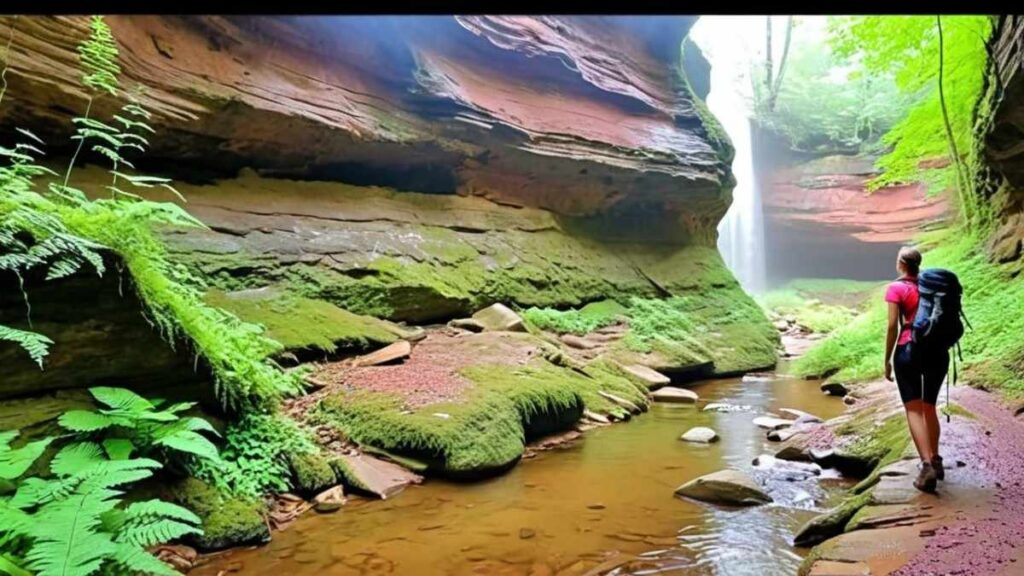
Introduction
A true classic among Indiana trails, Turkey Trail plunges you into deep sandstone ravines carved by Sugar Creek. Footbridges crisscross over clear water, while towering hemlocks and hardwoods form a cathedral‑like canopy overhead. Hiking here feels like stepping into an Indiana version of the Grand Canyon—on a smaller, more intimate scale. Early morning light streaks through the ravines, illuminating mist rising from the creek. Rockhouses and natural arches add an archaeological twist to your best hikes in Indiana bucket list.
Trail Distance, Difficulty, and Permit
- Distance: 1.7 miles (loop)
- Difficulty: Moderate (stone steps & narrow ledges)
- Permit: $7 daily vehicle fee
Best Time to Visit
Spring and fall bring ideal temperatures (55–70°F) and vibrant carpeted leaves. Early summer mornings offer cool creek crossings before the heat sets in.
Personal Tips & Safety Precautions
Wear sturdy hiking boots with aggressive tread—wet sandstone can be slippery. Bring a small camera for the hidden “rockhouse” alcoves, but watch your footing near edges. Pack an extra layer in spring: mornings in the ravines can stay surprisingly chilly.
2. Gorge Scenic Loop – Clifty Falls State Park
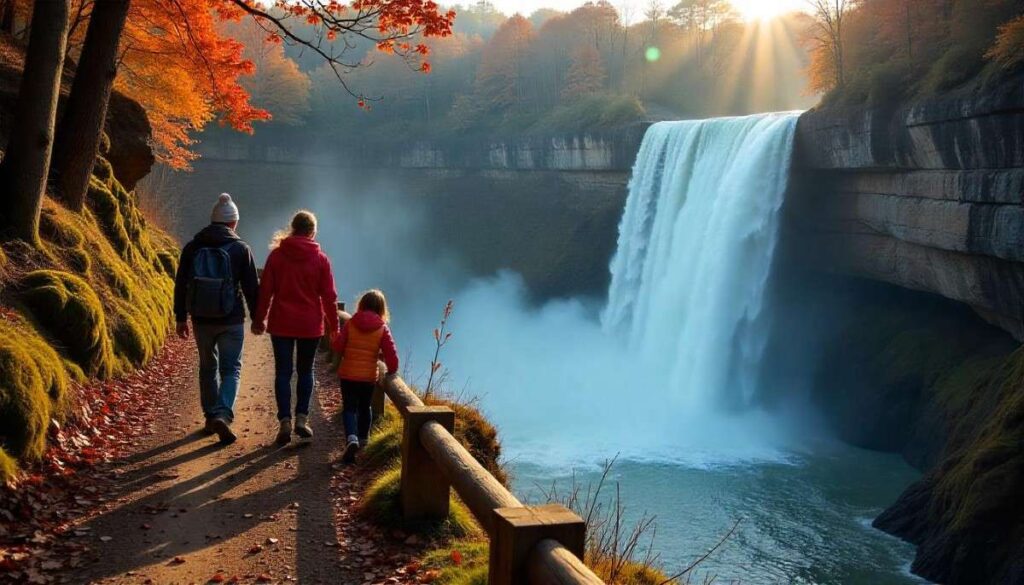
Introduction
Just east of Madison lies the Gorge Scenic Loop, a circuit that threads four waterfalls into one spectacular outing. Towering sandstone walls frame turquoise pools, and misty spray dances in the sun. At each cascade—Upper and Lower Clifty Falls, Cascade Falls, and Hoffman Falls—you’ll find easy viewpoints and interpretive signs explaining how ancient glaciers carved this dramatic canyon. This is one of the top waterfall hikes in Indiana, perfect for photographers and families alike.
Trail Distance, Difficulty, and Permit
- Distance: 2.6 miles (loop)
- Difficulty: Easy to moderate (well‑graded paths)
- Permit: $7 daily vehicle fee
Best Time to Visit
After spring rains (April–June) or during peak fall color (late October), when water flow and foliage contrast make every waterfall pop.
Personal Tips & Safety Precautions
Stay on designated paths—ledge drops can be steep. Bring a rain jacket or waterproof phone case to protect gear from waterfall spray. If you plan to picnic near Cascade Falls, arrive before noon to claim a shady table.
3. Wolf Cave Falls Trail – McCormick’s Creek State Park
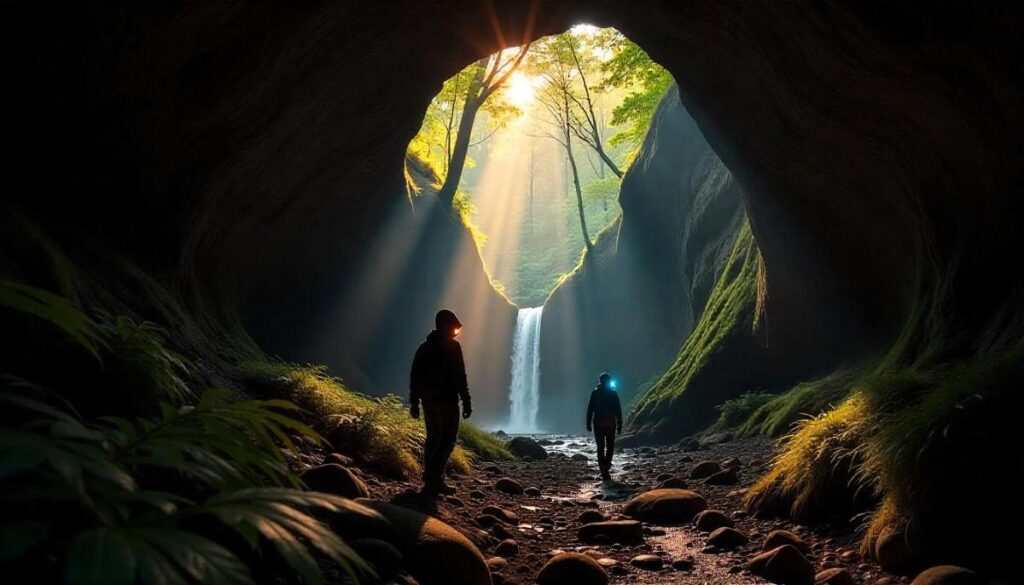
Introduction
At Indiana’s oldest state park, the Wolf Cave Falls Trail reveals a secret cavern above a hidden cascade. Hemlock‑lined cliffs channel cool mist into a small plunge pool, while the overhead canopy filters dappled sunlight onto ornate limestone carvings. This trail weaves past ancient fish‑scale fossil beds and a dramatic “Devil’s Punchbowl” pothole formed by swirling whirlpools. It’s one of the most atmospheric Indiana waterfalls hikes, blending geology, botany, and history into a single loop.
Trail Distance, Difficulty, and Permit
- Distance: 1.6 miles (loop)
- Difficulty: Easy to moderate (rocky sections)
- Permit: $7 daily vehicle fee
Best Time to Visit
Spring offers the fullest flow; fall brings a riot of color among the hemlocks and maples. Summer dawns are perfect for a cool forest walk.
Personal Tips & Safety Precautions
Pack a headlamp if you plan to explore Wolf Cave—daylight barely reaches its depths. Bring waterproof hiking sandals for mossy stream crossings. A small microfiber towel can help dry off before heading to the Amphitheater Trail.
4. Devil’s Backbone Section – Knobstone Trail
Introduction
For a mountains in Indiana‑style adventure, tackle the Devil’s Backbone on the Knobstone Trail. This rugged 5‑mile stretch rides a narrow sandstone crest, dropping steeply on both sides into hardwood valleys. On clear days, you can see the Ohio River glinting to the south. Wild blueberries dot the path in summer, while spring ephemerals carpet the forest floor. This is the state’s longest continuous trail and one of the most challenging adventure hiking trails in Indiana.
Trail Distance, Difficulty, and Permit
- Distance: 5 miles (one way)
- Difficulty: Strenuous (steep ascents and descents)
- Permit: Free (first‑come, first‑serve campsites)
Best Time to Visit
Late April–May for wildflowers, or September–October for crisp air and fewer ticks. Avoid midsummer heat on exposed ridges.
Personal Tips & Safety Precautions
Carry trekking poles for balance on loose shale. Water sources are scarce—plan to cache water or carry a filter. Hike with a partner: the exposed ridge can feel intimidating on solo trips.
5. Pine Hills Trail – Shades State Park
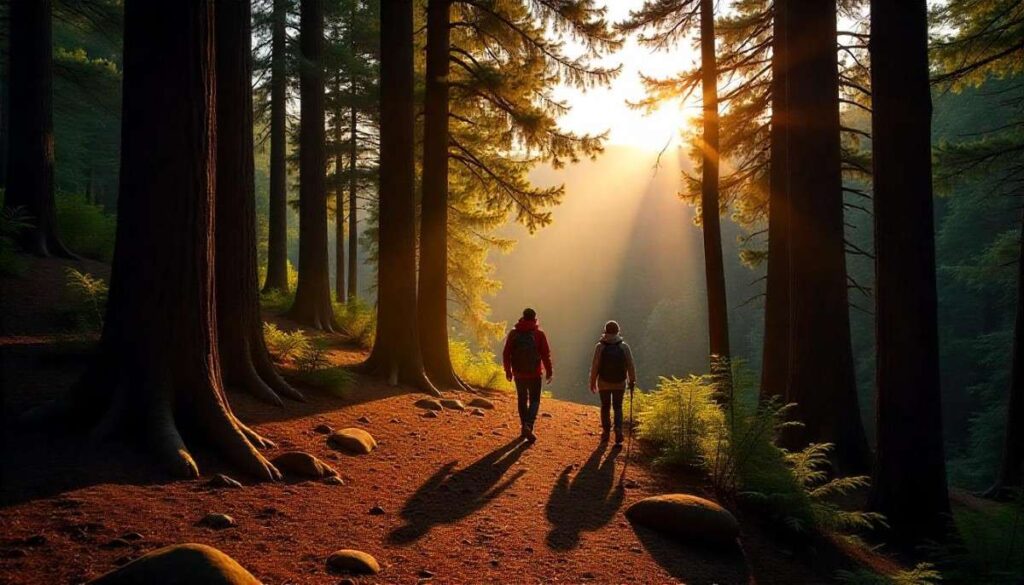
Introduction
Shades State Park’s Pine Hills Trail offers a mix of towering hemlocks, a historic fire tower site, and deep sandstone gorges. You’ll cross natural footbridges over Little Pine Creek and climb a ladder to a bluff overlook with bench seating. The air here stays cool even in summer, and the sandstone walls glow golden at sunset. This intimate 3‑mile loop is one of the best hidden gems of Indiana, beloved for its blend of river canyon drama and forest tranquility.
Trail Distance, Difficulty, and Permit
- Distance: 3 miles (loop)
- Difficulty: Moderate (rock steps & ladder)
- Permit: $7 daily vehicle fee
Best Time to Visit
Spring’s fresh ferns or fall’s flaming maples highlight the limestone walls. Early evening adds warm light to the sandstone crenellations.
Personal Tips & Safety Precautions
Wear gloves for the rungs on the ladder section. Bring a picnic blanket to relax at the bluff overlook. In wet weather, the creek crossings can rise quickly—check park alerts before heading out.
6. Hemlock Cliffs Trail – Chain O’Lakes State Park
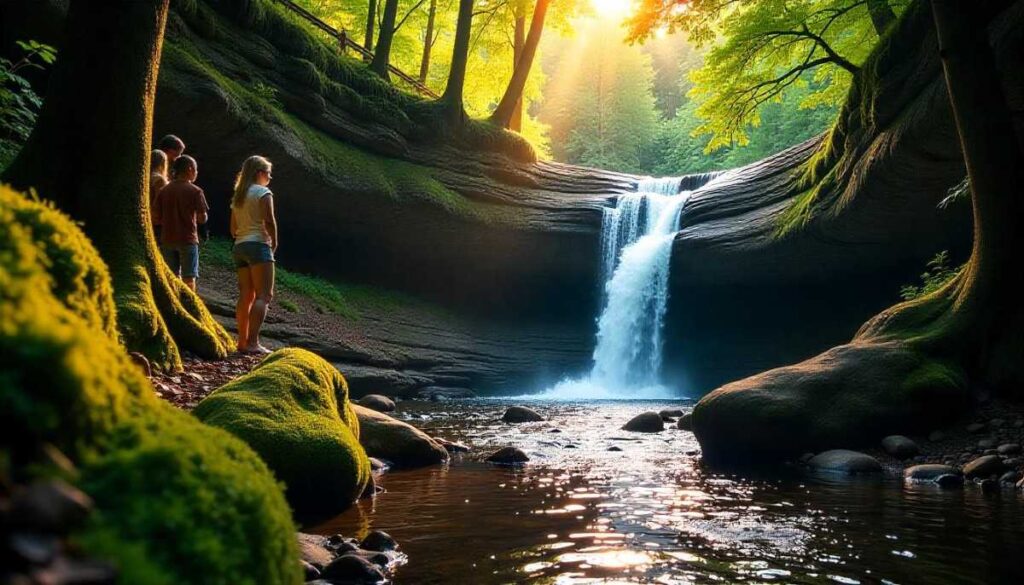
Introduction
Chain O’Lakes State Park hides one of northern Indiana’s most dramatic features: Hemlock Cliffs. This 4‑mile loop alternates between kettle lakes fringed with cattails and a hemlock‑shaded gorge where waterfalls trickle over mossy ledges. Painted turtles bask on fallen logs, and spring trout anglers often peek into the pools below. The trail’s shifting ecosystems—from wetlands to hemlock ravine—make it one of the most ecologically diverse Indiana hiking places.
Trail Distance, Difficulty, and Permit
- Distance: 4 miles (loop)
- Difficulty: Moderate (uneven roots & rocks)
- Permit: $7 daily vehicle fee
Best Time to Visit
Late spring when the water is high and wildflowers dot the forest floor. Fall’s golden hemlock needles create a magical carpet.
Personal Tips & Safety Precautions
Wear bug repellent—mosquitoes favor the wetlands. A small daypack with hydration bladder helps keep hands free for rock scrambling. Use trekking poles on root‑tangled sections to prevent slips.
7. Cowles Bog Trail – Indiana Dunes National Park
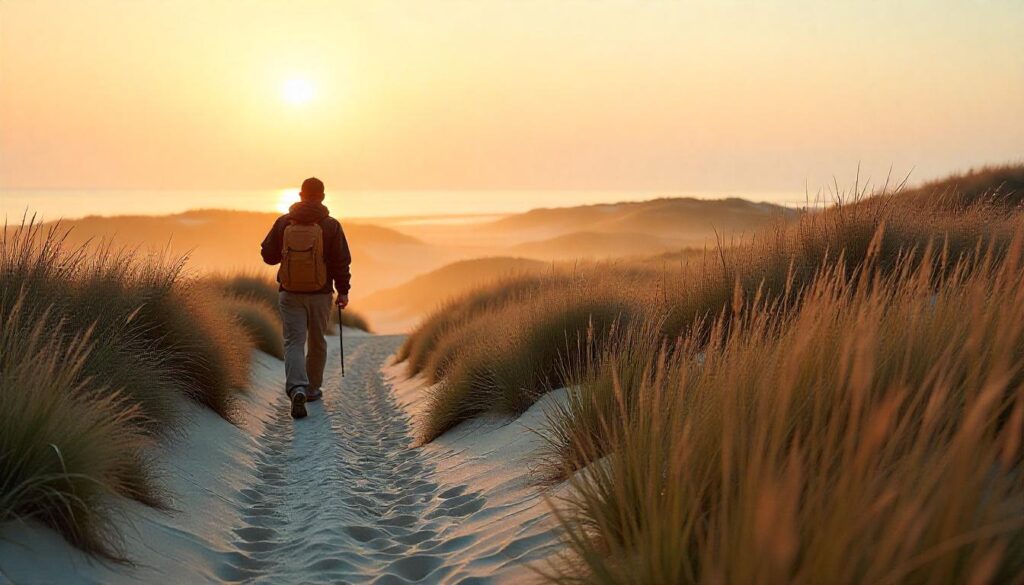
Introduction
The Cowles Bog Trail is a microcosm of Indiana Dunes National Park’s ecological variety. You’ll traverse freshwater marshes, climb woody dune ridges, and pass through restored prairie plots alive with native grasses and orchids. Birdwatchers flock here during migration to spot warblers and shorebirds resting in the wetlands. Interpretive signs explain dune succession, making this 3.5‑mile loop both a scenic hike and an outdoor classroom.
Trail Distance, Difficulty, and Permit
- Distance: 3.5 miles (loop)
- Difficulty: Easy to moderate (sandy uphill sections)
- Permit: Free, park entrance fee applies
Best Time to Visit
May–June for wildflower blooms and spring bird migration, or late September to avoid crowds and enjoy mild temperatures.
Personal Tips & Safety Precautions
Wear gaiters to keep sand out of your boots. Early morning hikes reward you with cooler air and the best bird activity. Carry binoculars and a field guide for a richer experience.
8. River Bluff Trail – Harmonie State Park
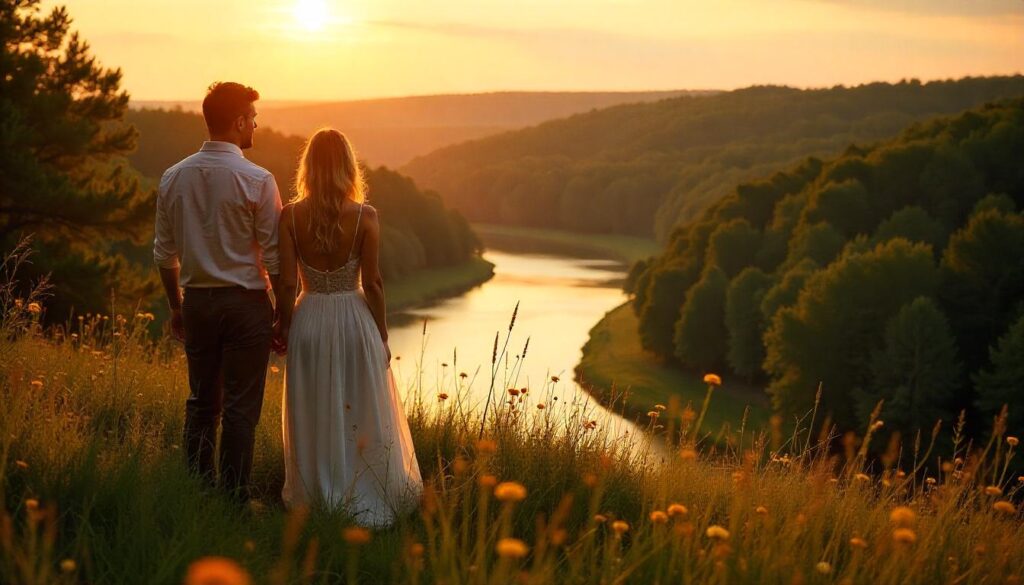
Introduction
Harmonie State Park’s River Bluff Trail clings to limestone cliffs overlooking the Ohio River’s meandering channel. Wildflower meadows slope down from the bluffs, while shaded woods harbor deer and wild turkey. Benches at scenic turnouts invite you to pause and watch barges drift below. This 2.2‑mile out‑and‑back is one of the top places to hike in Indiana for panoramic river vistas and easy access from nearby Mount Vernon.
Trail Distance, Difficulty, and Permit
- Distance: 2.2 miles (out-and-back)
- Difficulty: Easy (well‑graded path)
- Permit: $7 daily vehicle fee
Best Time to Visit
Spring for blooming wildflowers, or autumn when river haze clears and fall colors glow on the opposite bank.
Personal Tips & Safety Precautions
Pack a picnic—tables at the trailhead overlook are perfect for lunch with a view. Keep an eye on river levels after heavy rain. Wear sun protection: the ridge is exposed on summer afternoons.
9. Sycamore Loop – Prophetstown State Park
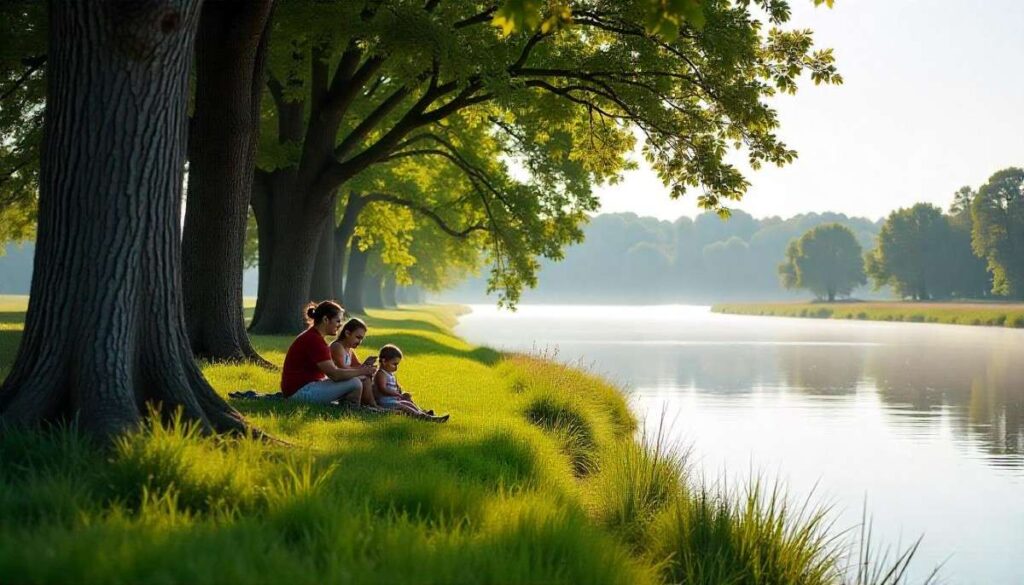
Introduction
A peaceful counterpoint to canyon hikes, the Sycamore Loop meanders through restored tallgrass prairie and oak savanna before skirting the Tippecanoe River’s edge. Sycamores dip their limbs into the slow‑moving water, creating shimmering reflections at dawn. Birders and wildflower enthusiasts will delight in the native blooms of coneflower and goldenrod. This 3.2‑mile loop is one of the best easy hikes in Indiana—ideal for families, trail runners, and anyone seeking a gentle connection with Midwestern prairie ecosystems.
Trail Distance, Difficulty, and Permit
- Distance: 3.2 miles (loop)
- Difficulty: Easy (flat terrain)
- Permit: $8 daily vehicle fee
Best Time to Visit
Late spring through early summer, when wildflowers peak and migratory songbirds fill the air with song.
Personal Tips & Safety Precautions
Bring binoculars for river‑edge birdwatching—kingfishers and herons are common. Wear insect repellent: ticks inhabit the prairie grasses. A lightweight daypack holds snacks and a reusable water bottle for the easy trek.
10. Cardinal Greenway Trail – Muncie to Marion
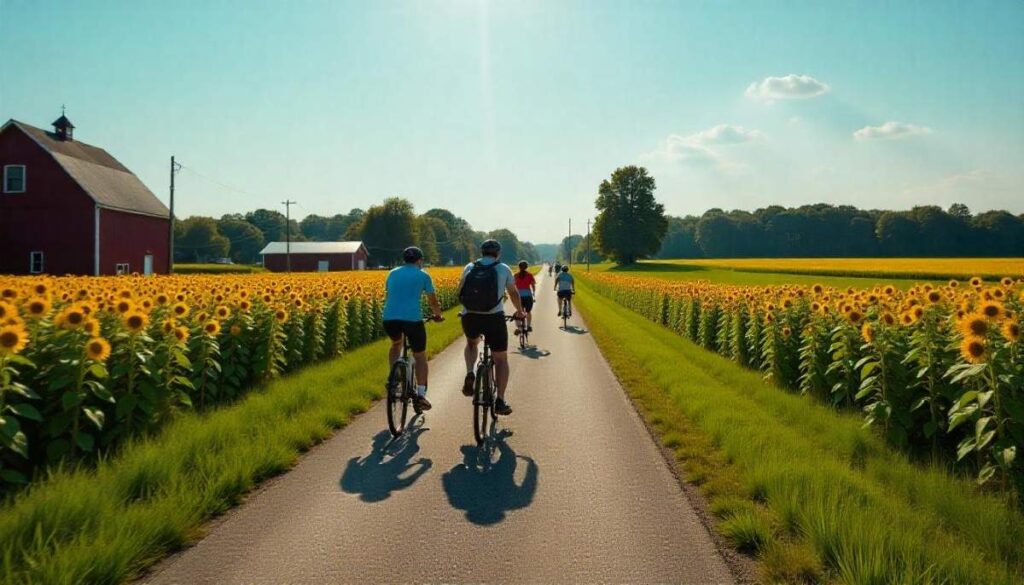
Introduction
As Indiana’s longest rail‑trail, the Cardinal Greenway spans 62 miles of former Pennsylvania Railroad bed between Muncie and Marion. Its gentle grade makes it perfect for multi‑sport use: hiking, biking, or even a leisurely walk with the dog. You’ll traverse small towns, farm fields, and shaded woodlots, with historic depot towns offering coffee stops and local eateries. This route exemplifies camping and hiking in Indiana’s heartland—accessible, community‑oriented, and scenic.
Trail Distance, Difficulty, and Permit
- Distance: 62 miles (end-to-end)
- Difficulty: Easy (graded railbed)
- Permit: Free, no fee required
Best Time to Visit
April–October for mild weather and local festivals along the route. Early mornings offer cool air and minimal traffic.
Personal Tips & Safety Precautions
Plan your sections around towns with services—some stretches have no water refill points. A hybrid hiking‑bike allows you to cover ground quickly and return on foot. Always signal when passing others and yield to equestrians if encountered.
Comparison Table of Best Hikes in Indiana
| Trail Name | Distance (miles) | Elevation Gain (ft) | Difficulty | Best Season | Quick Highlights |
|---|---|---|---|---|---|
| Turkey Trail – Turkey Run State Park | 4.5 | 731 | ⭐⭐⭐ Moderate | Spring & Fall | Sandstone ravines, ladders, Sugar Creek canyons |
| Gorge Scenic Loop – Clifty Falls State Park | 4.1 | 479 | ⭐⭐⭐ Moderate | Spring & Fall | Towering waterfalls, rocky gorges, panoramic overlooks |
| Wolf Cave Falls Trail – McCormick’s Creek State Park | 2.1 | 226 | ⭐⭐ Moderate | Spring & Early Summer | Hidden cave, cascading falls, limestone bluffs |
| Devil’s Backbone Section – Knobstone Trail | 58 | 20 000 | ⭐⭐⭐⭐⭐ Hard | Spring & Fall | Ridge‑line vistas, deep forest solitude |
| Pine Hills Trail – Shades State Park | 1.9 | 300 | ⭐⭐ Easy | Spring & Fall | Towering hemlocks, historic fire tower site |
| Hemlock Cliffs Trail – Chain O’Lakes State Park | 1.4 | 177 | ⭐⭐ Moderate | Spring & Summer | Kettle lakes, hemlock‑shaded gorge |
| Cowles Bog Trail – Indiana Dunes National Park | 1.5 | 70 | ⭐ Easy | Spring & Fall | Dune ridges, wetlands, restored prairie |
| River Bluff Trail – Harmonie State Park | 2.7 | 42 | ⭐ Easy | Spring & Fall | Ancient limestone bluffs, wildflower meadows |
| Sycamore Loop – Prophetstown State Park | 1.7 | 100 | ⭐ Easy | Spring & Summer | Restored tallgrass prairie, oak savanna |
| Cardinal Greenway Trail – Muncie to Marion | 27 | 200 | ⭐⭐⭐ Moderate | Fall | Nearly flat rail trail through farms and small towns |
Regional Hiking Breakdown
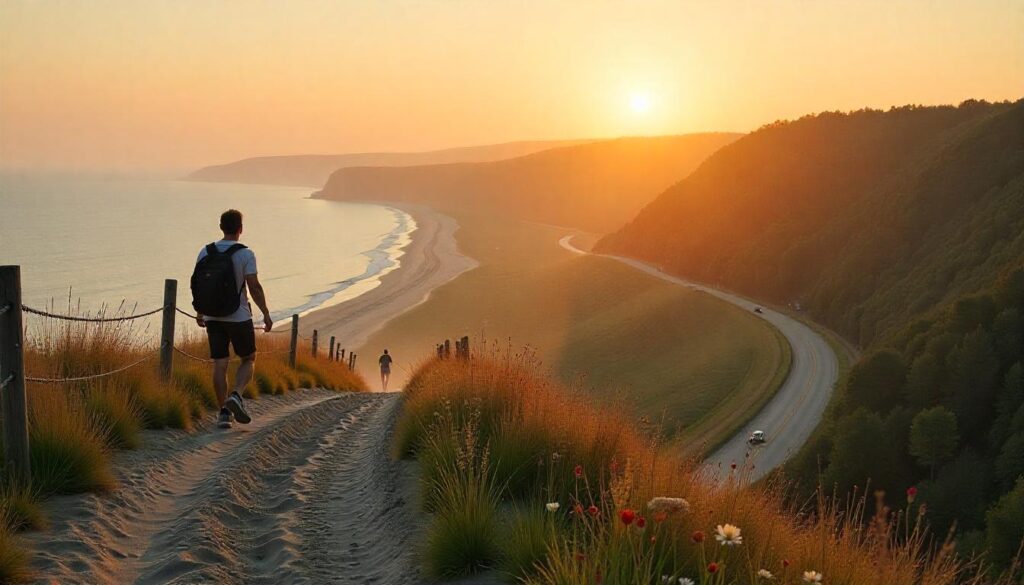
Indiana’s hiking scene shines when viewed region by region—each corner of the state offers distinct terrain, ecosystems, and trail experiences. Whether you crave the thunderous roar of waterfalls in the north, the rolling hills of the south, or easy urban escapes, this regional hiking breakdown helps you pinpoint the best areas for hiking in Indiana based on your interests and location.
Hiking in Northern Indiana
Northern Indiana is defined by its glacially sculpted landscapes, prairies, and cooling lakeshore breezes. From the rugged bluffs at the state’s highest waterfalls to the sandy ridges of the Dunes, this region packs a surprising variety of Indiana hiking trails within a few hours’ drive of Fort Wayne and South Bend.
Cataract Falls Indiana Hiking & Best Trails in Northern Indiana
Cataract Falls State Recreation Area boasts the largest waterfall in the state, where Spring Mill Creek plunges over two limestone ledges into a moss‑covered gorge. Nearby, Indiana Dunes National Park offers dune‑crest hikes and wetland boardwalks, while the Potato Creek State Park loops meander past meadows and woodlands. For a longer trek, the 7‑mile Potawatomi Trail at Chain O’Lakes winds through kettle lakes and hemlock ravines—ideal for spotting migrating songbirds.
Hiking in Southern Indiana
Southern Indiana’s rolling hills, sandstone gorges, and lush forests create a “mountain‑like” atmosphere that belies the state’s flat reputation. Here, the Knobstone Escarpment and Hoosier National Forest reveal steep ridges and hidden hollows—perfect for hikers seeking solitude and scenic drama.
Hiking Trails in Southern Indiana & Best Hikes in Southern Indiana
Clifty Falls State Park’s Gorge Scenic Loop threads four waterfalls into a single 2.6‑mile trek, while the Devil’s Backbone section of the Knobstone Trail climbs a narrow ridge with 360° views of the Ohio River Valley. In Hoosier National Forest, the Fern Hollow Nature Preserve features slot‑canyon hikes and seasonal waterfalls, and O’Bannon Woods State Park treats you to spring wildflowers along creekside paths.
Central Indiana Hiking
The heartland’s gentle hills and pastoral woodlands center around Indianapolis but extend into charming small‑town parks and riverfront greenways. Here, you’ll find a mix of family‑friendly loops and overnight backpacking routes amid meadows and hardwood forests.
Camping and Hiking in Indiana’s Heartland
At Turkey Run State Park, sandstone ravines and Sugar Creek crossings make for a rugged camping base. Eagle Creek Park in Indianapolis offers lakeside campgrounds plus flat, multi‑use trails ideal for beginners. Nearby, the Ten O’Clock Line Trail provides a 32‑mile loop through farmland and forest—perfect for section backpacking.
Pretty Places in Indiana & Beautiful Places in Indiana
Bloomington’s McCormick’s Creek State Park dazzles with Hemlock Cliffs and Wolf Cave Falls, while the Wabash River Trail in Lafayette winds along scenic bluffs. For wildflower displays, head to Fort Harrison State Park’s White River Greenway or Geist Reservoir trails just east of downtown Indianapolis.
Hiking in Indianapolis
As a thriving metro hub, Indianapolis surprises visitors with accessible green spaces and urban‑adjacent trails that feel worlds away from the bustle of downtown.
Hiking Trails in Indianapolis & Hiking Near Indianapolis
Eagle Creek Park’s 3,900 acres include the Bridges Trail, looping through wetlands and forest, and the Strawtown Koteewi Park north of the city offers 13 miles of dual‑use paths crossing meadows and creek valleys. The Fall Creek Greenway links downtown to Riley Hospital, passing under historic bridges and alongside wooded banks.
Hiking in Bloomington, Indiana
Home to Indiana University, Bloomington sits amid the sandstone bluffs and karst topography of Monroe County’s forested hills.
Hiking Around Bloomington Indiana & Best Hikes in Bloomington Indiana
The Wonderlab Discovery Trail near the Science Center offers hands‑on geology lessons, while Hoosier National Forest’s Three Creeks Loop treats you to cascading streams and spring wildflowers. For an easy sunset stroll, head to Leonard Springs Nature Park’s limestone sinkholes and small waterfalls.
Hiking in Fort Wayne, Indiana
Northeast Indiana blends urban parks with river‑corridor greenways, offering a surprising variety for city dwellers and weekend explorers.
Hiking Trails in Fort Wayne Indiana & Best Hiking Near Fort Wayne Indiana
Foellinger‑Freimann Botanical Conservatory backs onto Parkview Greenbelt, where forested trails wind through native plant gardens. Just east of town, the Salamonie River State Forest provides secluded backpacking loops along the meandering Salamonie River—perfect for a tranquil overnight trip.
Hiking in Lafayette, Indiana
The Wabash River curves through Lafayette and West Lafayette, offering riparian pathways and prairie remnants for local hikers.
Hiking Trails in Lafayette Indiana
The Lafayette Lovett Park Trails showcase restored oak savanna and wildflower meadows, while the Prophetstown State Park offers the Sycamore Loop along the Tippecanoe River. Combined with Purdue University’s Purdue University Nature Park, these trails create a mini‑network of trail‑tested routes just minutes from campus.
Brown County Indiana Hiking
Known as “Southern Indiana’s Little Smokies,” Brown County’s rolling hills and hardwood forests make it the state’s premier hiking destination.
Brown County Indiana Hiking Trails & Best Hiking in Brown County Indiana
The Brown County State Park features eight marked trails, from the short Ogle Hollow loop to the challenging Hickory Ridge trail. For a scenic summit, climb the Lookout Tower Trail on rugged ridges, or explore the creek‑lined Backcountry loop—both deliver panoramic hilltop vistas and vibrant autumn colors.
Hiking in Evansville, Indiana
Along the Ohio River, Evansville’s trails combine river‑bottom forests and urban greenways for a unique southern Indiana experience.
Hiking Near Evansville Indiana & Cool Parks in Indiana
Wesselman Woods Nature Preserve offers 240 acres of old‑growth bottomland forest with well‑maintained boardwalks. The Cane Ridge Trail at Burdette Park leads to a secluded waterfall, while Henderson County’s Cave River Valley Park adds spelunking opportunities and creekside paths to your southern Indiana itinerary.
Comparison Table of Reginal Hiking in Indiana
| Region | Representative Trail | Distance (miles) | Elev. Gain (ft) | Difficulty | Highlights |
|---|---|---|---|---|---|
| Northern Indiana | Cataract Falls Trail | 2.5 mi | 120 ft | ⭐⭐ Easy | Twin cascades, creekside boardwalks |
| Southern Indiana | Devil’s Backbone (Knobstone) | 58 mi | 20 000 ft | ⭐⭐⭐⭐⭐ Hard | Ridge‑line views, remote forest |
| Central Indiana | Fall Creek Trail (Fort Harrison SP) | 3 mi | 200 ft | ⭐ Easy–Moderate | Riverside paths, urban greenway |
| Indianapolis | Eagle Creek Park Orange Trail | 6 mi | 300 ft | ⭐⭐ Moderate | Lake views, birdwatching spots |
| Bloomington | Cascade Falls Trail (McCormick’s Creek SP) | 1.2 mi | 180 ft | ⭐ Easy | Waterfall overlook, hemlock forest |
| Fort Wayne | Eagle Marsh Preserve Loop | 4 mi | 50 ft | ⭐ Easy | Wetland boardwalks, migratory birds |
| Lafayette | Wildcat Creek Trail | 5 mi | 150 ft | ⭐⭐ Easy–Moderate | River views, limestone bluffs |
| Brown County | Lookout Tower Trail | 2.7 mi | 500 ft | ⭐⭐⭐ Moderate | Panoramic ridge vistas, fall foliage |
| Evansville | Wesselman Woods Loop | 2 mi | 80 ft | ⭐ Easy | Bottomland forest, birding hot spot |
Hidden Hiking Gems in Indiana
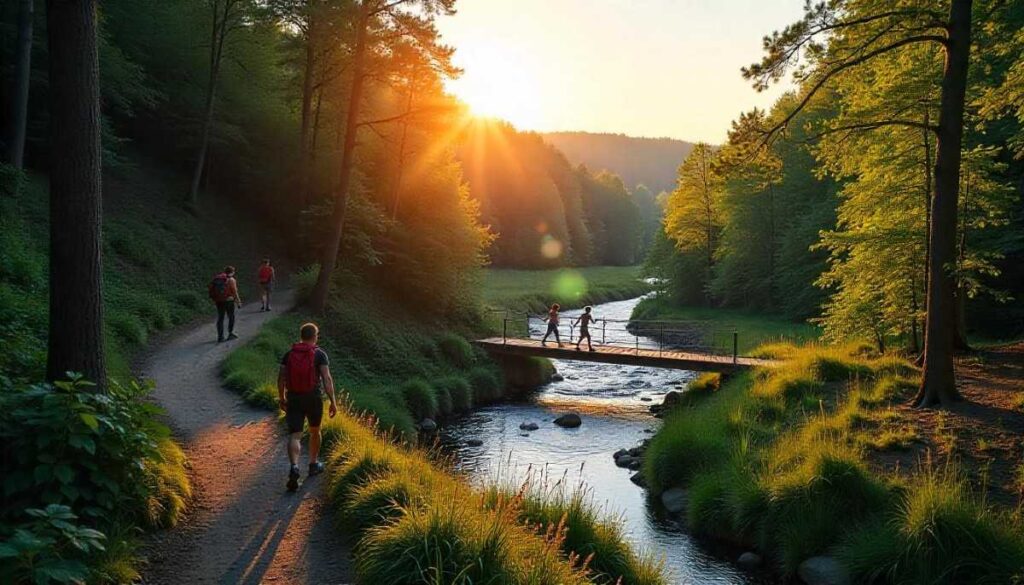
Why Explore Indiana’s Lesser-Known Trails
- Benefits of hiking hidden trails in Indiana
Discovering under-the-radar paths rewards you with unparalleled solitude and a deeper connection to nature. Unlike popular loops, these secret routes often showcase pristine forests, rare wildflowers, and unspoiled creek crossings. As an experienced Hoosier hiker, I’ve found that hidden trails sharpen navigation skills and uncover scenic features that escape mainstream guidebooks—perfect for building genuine expertise in hiking in Indiana. - Escape crowds and experience unique landscapes
Stepping off beaten paths lets you immerse yourself in Indiana’s most authentic landscapes. You’ll trade crowded overlooks for silent ravines, and paved trailheads for rustic entry points where wildlife sightings—deer, foxes, or even a red‑tailed hawk—feel serendipitous rather than staged. These lesser-known routes offer both mental refreshment and a sense of discovery that elevates any Indiana hiking adventure.
1. Adventure Hiking Trail – Clark State Forest
Tucked away in southern Indiana, the Adventure Hiking Trail at Clark State Forest is a true hidden gem of Indiana. This 3‑mile loop threads through dense hardwoods, rugged rock outcroppings, and moss‑draped limestone bluffs. With minimal signage, you’ll rely on GPS waypoints or a downloaded Indiana hiking trails map, honing your orienteering skills. Early morning hikes here often reward you with quiet moments alongside trickling tributaries—ideal for a reflective break away from well‑trodden Indiana trails.
Insider Tip: Wear sturdy boots with ankle support—the forest floor can hide loose shale and exposed roots after rain. If you strike out at finding the trailhead kiosk, follow local signage for “Trail 180” off State Road 203 and look for the small wooden arrow.
2. Trail 3 – Shades State Park
Shades State Park’s infamous Trail 3 is a short but adrenaline‑packed slot‑canyon experience. Ladder rungs attach to sheer sandstone walls, and narrow ravines funnel you through a maze of vertical cliffs. This 0.8‑mile scramble demands careful footing and a sense of adventure, making it one of the most challenging hiking places in Indiana. For experienced hikers seeking a taste of canyoneering, Trail 3 offers dramatic photo ops and a memorable workout.
Insider Tip: Bring lightweight gloves to grip the metal rungs, and pack a small first‑aid kit—scrapes on sandstone are common. Visit in late spring when daylight penetrates the canyon floor, lighting up the ochre walls.
3. Jackson‑Washington State Forest Trails
For multi‑day backpacking in Indiana, the Jackson‑Washington backpacker loop delivers rustic charm and genuine solitude. Spanning 24 miles across Southern Indiana’s oak‑hickory ridges, you’ll camp at primitive sites beneath towering pines. Creek crossings provide natural water sources—just remember to purify before drinking. This network of trails is seldom featured on mainstream lists, making it perfect for building real Indiana backpacking trails expertise.
Insider Tip: Plan water caches at known springs in the forest. Local hikers recommend the Maple Springs area as a reliable refill point, even in late summer droughts.
4. Salamonie River State Forest Trails
Northern Indiana’s Salamonie River State Forest offers a tranquil escape from the Dunes’ crowds. Its 14‑mile loop winds through river bottom hardwoods and secluded meadows, with occasional riverbank campsites. Anglers love the clear Salamonie River pools, while birdwatchers spot belt‑colored monarchs on milkweed in late fall. These often-overlooked hiking trails in Indiana with waterfalls include small seasonal cascades along tributary streams.
Insider Tip: Check forest office notices—parts of the loop close briefly for timber management. Hike early in the day to catch mist rising off the river at dawn.
5. French Lick Scenic Trails
Southwest Indiana’s French Lick area combines historic charm with natural beauty. The French Lick Scenic Trails network links gentle loops around the West Baden Springs Hotel with woodland paths ascending rocky ridges. Seasonal wildflowers and historic mining remnants add cultural depth to your hike. This hidden corridor offers both casual walking trails for families and steeper routes for adventure hiking trail Indiana enthusiasts.
Insider Tip: Pair your hike with a soak at the adjacent French Lick Resort—after a stack of hills, the mineral springs feel especially restorative. For best views, tackle the Sunset Loop just before evening light fades.
Comparison Table of Hidden Hiking Gems in Indiana
| Trail Name | Distance | Elevation Gain | Difficulty | Best Season | Quick Highlights |
|---|---|---|---|---|---|
| Clark State Forest | 6.5 mi | 800 ft | ⭐⭐⭐⭐ Moderate | Spring–Fall | Winding fire‑road loops, creek crossings, knobs & ridges with skyline views |
| Shades State Park | 1.5 mi | 400 ft | ⭐⭐⭐ Moderate | Spring–Fall | Slot canyon‑style ravines, metal ladders, dramatic sandstone overlooks |
| Jackson‑Washington State Forest Trails | 10 mi | 900 ft | ⭐⭐⭐⭐ Moderate | Spring–Fall | Remote backpacking, river corridors, backcountry campsites |
| Salamonie River State Forest Trails | 8 mi | 250 ft | ⭐⭐⭐ Moderate | Spring–Summer | Ravine overlooks, small waterfalls, mixed hardwood & pine forests |
| French Lick Scenic Trails | 2.5 mi | 350 ft | ⭐⭐ Easy | Summer–Fall | Historic resort vistas, fern‑lined hollows, tranquil lake shore views |
Best Hiking in Indiana: Top Trails & Experiences
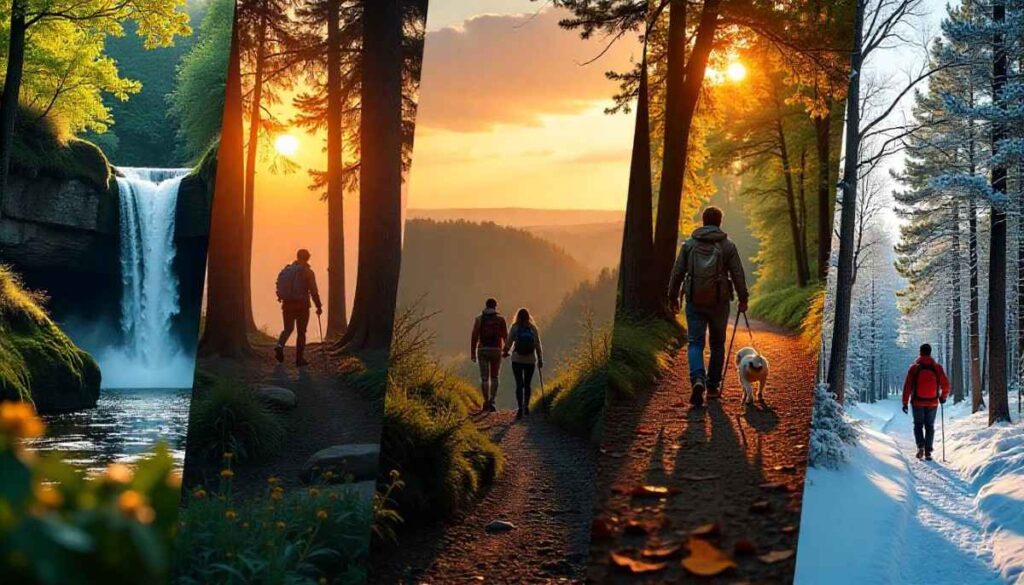
Best Day Hikes in Indiana
When you need a full‑flavor Indiana hiking fix in just a few hours, these best day hikes in Indiana deliver dramatic scenery without the overnight gear haul. Turkey Trail at Turkey Run State Park plunges into sandstone ravines and looping footbridges over Sugar Creek, while Clifty Falls’ Gorge Scenic Loop threads four waterfalls into a single 2.6‑mile circuit. For a cooler forest escape, Wolf Cave Falls at McCormick’s Creek offers hemlock‑shaded cliffs and hidden caverns. Each of these places to hike in Indiana lets you soak up the state’s wild beauty and still be home by dinnertime.
Adventure Hiking Trail Indiana & Intermediate Hikes Near Me
Craving heart‑pounding ridgelines and technical terrain? The Devil’s Backbone section of the Knobstone Trail tests your balance on narrow sandstone crests, while Shades State Park’s Trail 3 challenges you with ladder climbs and slot‑canyon scrambling. Hemlock Cliffs at Chain O’Lakes weaves you into a deep ravine via rocky switchbacks, and the Jackson‑Washington Backpacker Loop rewards multi‑day hikers with primitive campsites and river crossings. These adventure hiking trails in Indiana and intermediate hikes near me require sturdy boots, careful navigation, and a taste for rugged solitude.
Easy & Family Friendly Hikes in Indiana
Introduce young hikers to the joys of hiking places in Indiana with gentle loops that blend nature discovery and easy terrain. Hidden Hollow Loop at Hobbs State Park offers shady fern groves and interpretive signs along its 1‑mile circuit, while the Sycamore Loop at Prophetstown winds through restored prairie and riverbank paths. Cowles Bog Trail in Indiana Dunes National Park showcases wetlands and dune ridges in a 3.5‑mile loop that’s both educational and stroller‑friendly. These easy hikes in Indiana prove you don’t need steep climbs for memorable family outings.
H3. Dog Friendly Hiking Trails in Indiana
Your four‑legged pals are welcome on many Indiana trails, especially in state parks that provide water spigots and wide paths. At Brown County State Park, dogs on leash can accompany you on the Backcountry Loop or the Ogle Hollow trail, both offering creek crossings and abundant wildlife. Clifty Falls permits leashed pets on most overlooks and gentle loops, giving pups a chance to splash at Cascade Falls. Always carry extra water and a collapsible bowl, and remember to clean up after your dog to protect these dog friendly hiking trails in Indiana for everyone. If you want to hike with your dog then our hiking with dogs guide will be really helpful for you.
H3. Best Winter Hikes in Indiana
Don’t let frost keep you indoors—Indiana’s winter trails offer crisp air, quiet forests, and even frozen waterfall spectacles. Pokagon State Park’s trails wind past ice‑frozen cascades at Hidden Lake, where snow‑capped hemlocks frame each viewpoint. Eagle Creek Park’s bridges and boardwalks remain sturdy under light snow, making it a prime spot for a peaceful lakeside stroll. Turkey Run in winter reveals stark, snow‑dusting on sandstone walls. These best winter hikes in Indiana demand microspikes, insulated layers, and extra attention to daylight hours.
Best Hiking in Brown County Indiana
Known as the “Little Smokies,” Brown County’s rolling hills and hardwood forests shine brightest in fall, but offer year‑round allure. The Lookout Tower Trail delivers panoramic ridge views, while the rugged Hickory Ridge loop challenges you with rock scrambles and creek crossings. For a gentler pace, the Backcountry Loop meanders through oak savanna and quiet hollows. With over 40 miles of Brown County Indiana hiking trails, this park is a top pick for best hiking in Brown County Indiana, especially when autumn colors set the hills ablaze.
Best Trails Indiana Dunes National Park
For coastal intrigue, Indiana Dunes hiking is unbeatable. The Cowles Bog Trail showcases ecological diversity—from marshland boardwalks to prairie restorations and dune crest climbs. The Dune Succession Trail offers a concise lesson in landscape evolution, while the West Beach Trail lets you walk directly on the lakeshore sands. For solitude, tackle the 15‑mile Long Lake Trail through wetlands and forested dunes. These best trails Indiana Dunes National Park capture Lake Michigan’s shifting moods and underscore why hiking at Indiana Dunes remains a must for every Hoosier explorer.
Comparison Table of Hiking in Indiana
| Trail Name | Distance (mi) | Elevation Gain (ft) | Difficulty | Best Season | Quick Highlights |
|---|---|---|---|---|---|
| Wolf Cave Falls Trail – McCormick’s Creek SP | 2.1 | 226 | ⭐⭐ Moderate | Spring & Summer | Hidden cave, cascading waterfall, limestone bluffs |
| Devil’s Backbone – Knobstone Trail | 58 | 20,000 | ⭐⭐⭐⭐⭐ Hard | Spring & Fall | Rugged ridge-line views over southern Indiana’s hills |
| Cowles Bog Trail – Indiana Dunes NP | 1.5 | 70 | ⭐ Easy | Spring & Fall | Dune ridges, wetlands, restored prairie ecosystem |
| Eagle Creek Orange Trail – Eagle Creek Park | 6.7 | 300 | ⭐⭐ Moderate | Spring & Fall | Lake vistas, migratory bird habitat, mixed-use path |
| Trail 3 – Pokagon State Park | 1.5 | 100 | ⭐⭐ Moderate | Winter | Frozen cascades, snow‑draped hemlock groves |
| Lookout Tower Trail – Brown County SP | 2.7 | 500 | ⭐⭐ Moderate | Fall | Panoramic ridge vistas, vibrant autumn foliage |
| Dune Succession Trail – Indiana Dunes NP | 2.4 | 100 | ⭐ Easy | Spring & Fall | Ecological succession zones, informative interpretive signs |
Seasonal Hikes in Indiana (Month-by-Month Guide)
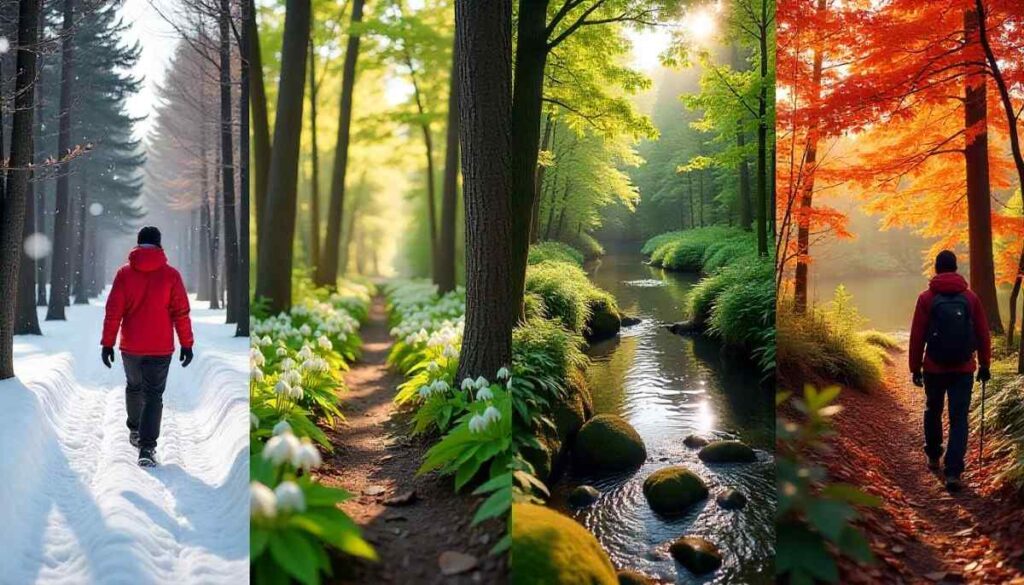
Indiana’s diverse landscape—from rolling hills and dense forests to lakeshore dunes and rocky ravines—offers something fresh and visually stunning with each season. Whether you’re seeking wildflower-filled canyons in spring, vibrant foliage in fall, or quiet snow-draped solitude in winter, planning your hikes by season can elevate your outdoor experience and help you stay safe and prepared. This guide explores seasonal hikes in Indiana, helping you pick the best time to hike in Indiana and find hidden gems every month.
Why Seasonal Hiking in Indiana Matters
Landscape changes, weather, and trail safety
Hiking in Indiana is more than just picking a trail—it’s about timing it right. Each season transforms the terrain, from muddy spring ravines to snow-covered forests. Knowing when to hike specific trails not only improves the scenery but also enhances safety. For example, trails with steep climbs may be slick during winter or early spring, while shaded forest trails provide relief during peak summer heat.
Maximize experience based on best time to hike in Indiana
Understanding seasonal trends allows hikers to match trails with their preferences. Want cascading Indiana waterfalls? Spring is your season. Looking to immerse in vivid leaf color? Hit the hills in fall. Interested in solitude and crisp air? Winter has you covered. Planning your trip around the best time to hike in Indiana also ensures you’re dressed properly, carrying the right gear, and avoiding seasonal trail closures or crowds.
Best Hikes by Season
Spring (March to May)
See Indiana waterfalls and wildflowers blooming
Spring in Indiana breathes new life into the landscape. Melting snow and seasonal rains turn dry creeks into roaring waterfalls, and woodlands burst with blooming wildflowers like trilliums, Dutchman’s breeches, and Virginia bluebells. The damp ground also adds a mystical touch, with foggy mornings and glistening trails.
Best hikes: Trail 9 at Indiana Dunes, Turkey Run State Park
Trail 9 at Indiana Dunes State Park is a springtime must. This moderate 3.75-mile trail winds through forested dunes and opens up to panoramic Lake Michigan views. In spring, you’ll spot migratory birds, budding trees, and less foot traffic than in summer. Wear waterproof boots—sections can be muddy.
Turkey Run State Park’s Trail 3 is another standout. Known for its rugged ladders, slot canyons, and waterfalls, the trail is particularly dramatic in spring when Sugar Creek swells and cascades surge. Early spring hikers should watch for slick rocks and dress in layers.
Gear tips:
- Waterproof hiking boots
- Lightweight rain jacket
- Trekking poles for steep/muddy terrain
- Bug spray (mosquitoes awaken in late spring)
Summer (June to August)
Ideal for camping and hiking in Indiana
Summer opens up long daylight hours, warmer water for creek crossings, and plenty of camping opportunities. While midday heat can be intense, starting early or choosing shaded routes helps beat the temperature. It’s also a prime season for family-friendly hikes in Indiana, as schools are out and nature programs are in full swing.
Best hikes: Brown County Indiana, Fort Harrison State Park
Brown County State Park is lush and vibrant in summer. Try the Abe Martin Trail or Rally Campground Loop, offering scenic overlooks and fern-covered forest floors. Wildlife is active, and morning hikes may reward you with deer or turkey sightings. Don’t miss the cool shade along Ogle Hollow Nature Preserve.
Fort Harrison State Park near Indianapolis offers accessible hiking near me for locals. Lawrence Creek Trail and Fall Creek Trail feature wildflowers, creek-side views, and plenty of shaded forest. It’s also a great spot for a quick weekday hike or picnic after work.
Gear tips:
- Hydration pack or refillable bottles
- Hat and sun-protective clothing
- Lightweight breathable layers
- Insect repellent and sunscreen
Local tip: Try camping at nearby Yellowwood State Forest for a quieter experience than Brown County but equally scenic. For detailed summer hiking guide you should click here.
Fall (September to November)
Explore most beautiful places in Indiana with fall colors
Fall hiking in Indiana is nothing short of magical. Rolling hills ignite in fiery reds, oranges, and golds. Temperatures cool off, bugs disappear, and the crisp air makes every step more refreshing. It’s the best time to explore Indiana’s high-elevation parks, ridge trails, and scenic places in Indiana.
Best hikes: Trail 8 at Indiana Dunes, Brown County Lookout Tower Trail
Trail 8 at Indiana Dunes State Park loops into Trail 4 and 9 to create a breathtaking loop that includes sandy ridges, wooded valleys, and peekaboo lake views. Come in mid-October for prime foliage, especially when looking west from dune overlooks.
Lookout Tower Trail in Brown County State Park leads you to sweeping panoramic views from Indiana’s highest vista. Combine it with Trail 5 or 7 for a longer hike through color-rich hardwoods. The trails are dry, leaf-covered, and less crowded mid-week.
Gear tips:
- Lightweight layers (temps can swing widely)
- Camera or phone for fall color photos
- Trail map (fallen leaves can obscure paths)
- Hiking boots with good grip
Insider advice: Arrive early or visit on weekdays—fall weekends draw large crowds. Nearby Nashville, IN offers cozy cafes and local shops for post-hike treats.
Winter (December to February)
Great for best winter hikes in Indiana
Winter may seem off-limits for hiking, but with the right gear and planning, it becomes a season of quiet, frozen beauty. Snow-blanketed trails offer solitude, peaceful woods, and the occasional view of frozen waterfalls in Indiana—a rare and breathtaking sight.
Best hikes: Pokagon State Park’s frozen waterfalls, Eagle Creek Park
Pokagon State Park in northern Indiana is a hidden gem for winter hiking. Its trails lead to frozen cascades and snow-draped forests. Trail 3 and Trail 6 offer gentle elevation and great winter lake views. It’s also one of the few parks with on-site sledding, making it perfect for families.
Eagle Creek Park in Indianapolis is ideal for quick winter hikes. The Orange and Red Trails stay well-trodden and provide boardwalks over icy marshes. Keep an eye out for wintering birds and frozen lake scenes.
Gear tips:
- Insulated hiking boots
- Microspikes or traction cleats
- Thermal base layers and weatherproof outerwear
- Flashlight or headlamp (short daylight hours)
Local tip: Carry a thermos with hot tea or cocoa. It helps you warm up mid-hike and adds a cozy touch to a chilly adventure.
Essential Indiana Hiking Resources
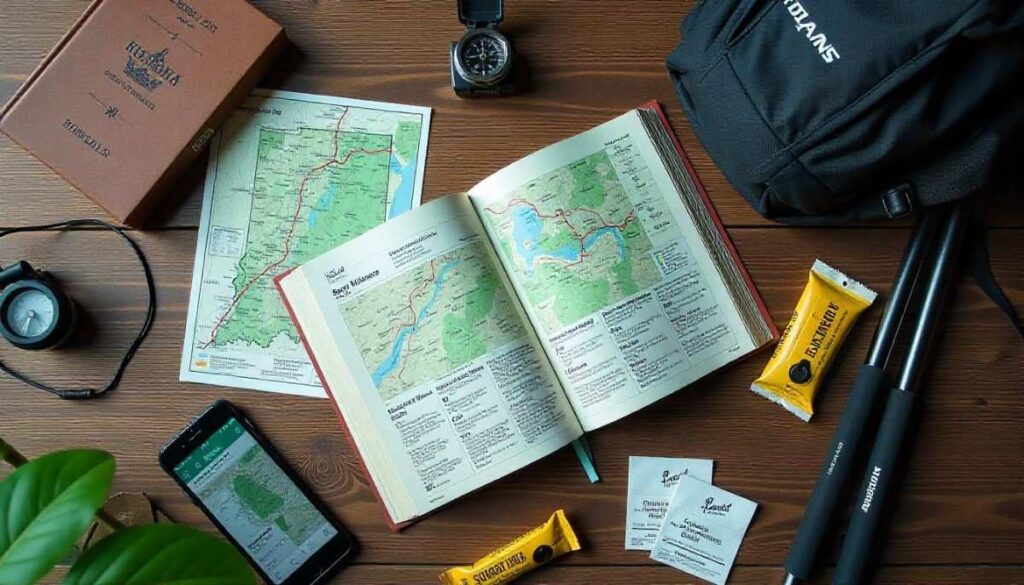
Planning a hike in Indiana involves more than just choosing a trail. Having the right tools and trusted resources can make the difference between an average outing and a memorable, safe experience. Whether you’re tackling the best hiking trails in Indiana or exploring hidden hiking gems, these hiking resources are key to preparation and confidence on the trail.
Indiana Hiking Map & Guidebooks
For hikers who love physical references or want a deeper connection with local geography, hiking guidebooks and printed trail maps offer reliable, offline insights. These resources often include detailed descriptions, elevation charts, and insider notes that digital platforms may miss.
- Recommended Maps: The Indiana State Parks Trail Maps and Hoosier National Forest Hiking Maps are excellent for both casual and experienced hikers. They cover trail lengths, difficulty ratings, and even historical notes, which can help enrich your hiking experience.
- Best Guidebooks: Hiking Indiana by Phil Bloom and 60 Hikes Within 60 Miles: Indianapolis are two highly rated books that cover a wide variety of hikes—from family-friendly trails in Indiana to advanced rugged hikes. These books are particularly helpful when hiking in cell service dead zones or for planning multi-day trips.
Hiking Tip: Always carry a physical map if you’re heading into remote areas like the Adventure Hiking Trail or the Jackson-Washington State Forest, where GPS signals may be unreliable.
Top Apps & Websites for Trail Info (AllTrails, Gaia GPS)
Digital tools have become essential for modern hikers. Whether you’re tracking distance, reviewing elevation gain, or reading real-time trail conditions, these apps keep your hike smart and safe.
- AllTrails: Arguably the most popular hiking app for both beginners and seasoned adventurers. AllTrails offers interactive maps, user reviews, trail photos, and downloadable GPS data. It’s particularly helpful when looking for dog-friendly hiking trails in Indiana or filtering by trail difficulty.
- Gaia GPS: Preferred by backpackers and off-the-grid hikers, Gaia GPS provides topographical overlays, weather forecasting, and route planning features. It’s ideal for exploring areas like Salamonie River State Forest or Brown County Indiana hiking trails with more autonomy and precision.
- Other Helpful Tools:
- Indiana DNR Website: Offers updated trail closures, alerts, and seasonal tips.
- Google Earth & Maps: Great for getting a bird’s-eye view of terrain before heading out.
- Strava: Excellent for tracking hikes and comparing routes with other local outdoor enthusiasts.
Pro Tip: Download your trail map before arriving. Many hiking areas in Indiana, especially rural or backcountry spots, have weak mobile signals.
Local Clubs, Tours & Events for Hiking in Indiana
Joining a local hiking group or participating in guided hikes can elevate your outdoor experience—especially if you’re new to Indiana hiking or looking to explore lesser-known hiking trails.
- Hoosier Hikers Council (HHC): A volunteer-based organization dedicated to building and maintaining hiking trails in Indiana. They offer group hikes, trail maintenance events, and conservation workshops.
- Indiana Sierra Club: The local chapter frequently hosts guided hikes, outdoor advocacy events, and beginner-friendly trail outings that highlight eco-friendly hiking in Indiana.
- State Park Programs: Many Indiana State Parks, including Turkey Run, McCormick’s Creek, and Fort Harrison, host seasonal hikes like wildflower walks, fall foliage tours, and night hikes, all led by expert naturalists.
- Online Meetups & Facebook Groups: Look for communities such as Indiana Hiking & Backpacking or Midwest Women’s Outdoor Collective. These groups share trail updates, organize group hikes, and often include insider tips from locals.
Hiker Insight: Joining clubs or guided tours is a great way to learn safe trail practices, discover hidden trails in Indiana, and meet people who share your outdoor interests—especially useful for beginners or solo hikers.
Frequently Asked Questions (FAQs) About Hiking in Indiana
Best Time of Year to Go Hiking in Indiana
The best time to hike in Indiana is spring (April–May) and fall (September–October) when temperatures are mild and trails like Turkey Run and Indiana Dunes are bursting with color. Avoid peak summer heat and icy winter conditions unless you’re prepared.
Hiking with Kids or Pets in Indiana – Family-Friendly Trails
Yes, Indiana offers many family-friendly and dog-friendly hiking trails. Parks like Eagle Creek, Fort Harrison, and McCormick’s Creek have well-maintained, easy loops perfect for kids and leashed pets, with rest areas and gentle terrain.
Indiana Hiking Safety Tips – Weather, Wildlife & Regulations
Always check local trail conditions and weather forecasts before heading out. Wear proper footwear, carry water, and be aware of ticks, poison ivy, and park regulations. In remote areas, bring a physical Indiana hiking map in case of GPS issues.
What Are the Most Scenic Hiking Trails in Indiana?
Some of the most scenic hiking spots include Trail 9 at Indiana Dunes, Hemlock Cliffs, and Brown County Lookout Tower Trail. These trails offer stunning views, forest canopies, and seasonal color changes that showcase the best hiking in Indiana.
Are There Any Waterfall Hikes in Indiana?
Yes, Indiana has several waterfall hikes, especially in spring. Top spots include Cataract Falls, Clifty Falls State Park, and Tunnel Falls at Turkey Run, offering beautiful scenery and great photo opportunities after recent rainfall.
How Difficult Are Hiking Trails in Indiana?
Hiking trails in Indiana range from easy loops to challenging backcountry routes. Beginner trails are abundant in parks like Shades State Park, while advanced hikers can tackle rugged trails in Clark State Forest or the Adventure Hiking Trail.
Conclusion
Indiana might not always top the list of hiking destinations—but once you explore its rugged canyons, peaceful forests, lakeside trails, and hidden waterfalls, it leaves a lasting mark on your soul. From adventure hiking trails in Southern Indiana to peaceful family-friendly paths near Indianapolis, the state offers something for every type of hiker.
Whether you’re chasing wildflowers in the spring, enjoying crisp air and fall colors in Brown County, or exploring snow-dusted trails in Pokagon State Park, each season opens a new chapter of outdoor beauty. For those seeking solitude, hidden gems like Shades State Park or the Salamonie River Forest offer serene moments where it’s just you and the trail.
Hiking in Indiana isn’t just about fitness or checking off destinations—it’s about reconnecting with nature, slowing down, and finding peace in the rustling leaves and flowing creeks. With tools like Indiana hiking maps, AllTrails, and helpful local hiking clubs, you’re never far from your next unforgettable journey.
So whether you’re a weekend warrior, a solo explorer, or a family with kids and pets, pack your gear, choose your trail, and discover the best hiking in Indiana—beautiful places, hidden paths, and pure Midwestern magic await.

